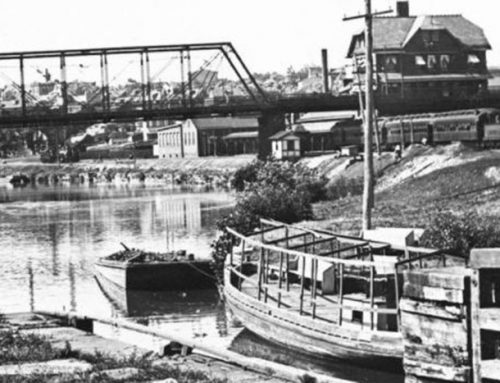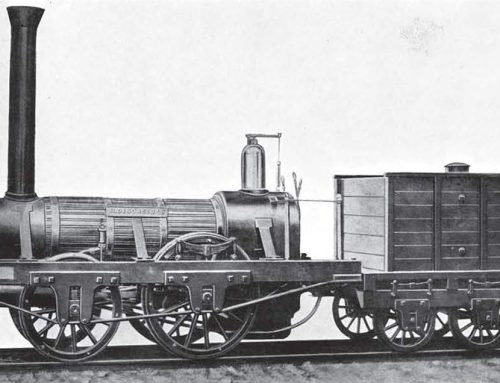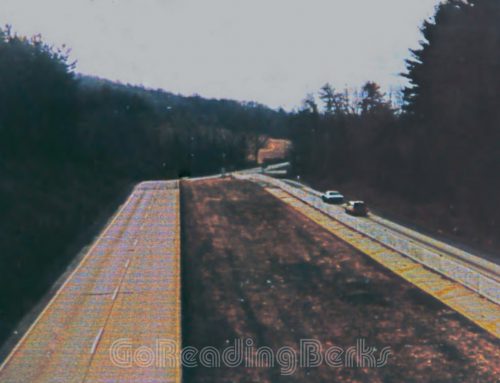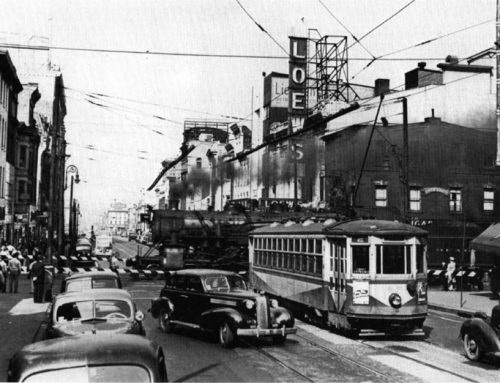At the turn of the 20th century there were few means of travel. Of course, there was the horse and carriage, which was fine, if the city dweller had one. There were some foolish people, too, who were making use of that new-fangled thing, the automobile, but neither they, nor it, would ever come to anything but a bad end! And so, to the vast majority, the trolley-car was the answer to the desire to travel, and travel they did. Nothing could be finer, on a warm Sunday evening, than for mother to clamber with the children on to a seat in the old open car for a trip to the end of the line and back – mother to enjoy the cooling breeze, while the youngsters, especially quiet for a change, half full of delight-and half fearful (especially if one was privileged to sit on the end of the seat and hold the guard chain), enjoyed the experience of rapid motion. Or perhaps a real outing would be planned, when the family would walk to Third and Penn Streets on a cool autumn afternoon, there to take a trolley-car as far as Mohnsville, or even Adamstown, a trip which took two hours or more.
And then, of course, the trolley-car made it much more convenient to go on a picnic. At such a time mother would pack a lunch, and the car would take the family to Mineral Springs Park, where the day, for the small boy, was spent in operating the old wooden swings, or scrambling about the neighboring hill sides, or wading in the stream, turning over rocks in hope of finding a cray-fish or two, and fearful of doing so! Of course, if a more strenuous day was planned, the car carried the family to Carsonia, half picnic grove and half amusement park, equipped was planned, the car carried the family to Carsonia, half picnic grove and half amusement park, equipped with those delights of childhood, the merry-go-round, the roller-coaster, and the miniature train.
Or, if a rare occasion was to be celebrated, the family could go to Nineteenth and Perkiomen, there to embark on the adventure of a lifetime, a trip “up the Gravity.” This was not a part of the street-railway system, but a line operated by a private company, running from the city up over Mount Penn, along the top, and then down again, forming a complete circuit, with one way traffic. At first driven by a steam engine, then electrically propelled, the high wheeled open car rode sometimes through the trees, sometimes above their tops, twisting and turning, until it reached the top of the mountain, where were located the Tower and the Tower Hotel. The former, a huge high affair of stone and wood, commanded a view of both sides of the mountain, but the little boy was not too much interested in scenery. His preference was to climb the tower to thrill at the height, or to watch the skill of the patrons of the bowling alleys which were part of the place. And then, of course, there was the trip back, when the car, with 110 need of propelling power, traveled by the force of gravity down the mountain side in long sweeps and curves, accompanied, as the flanges of the wheels pressed heavily against the rails, by the most eerie of shrieks that could please the ears of a youngster.
Buses replaced the cars on weekends after September 1, 1951 and trolley service in Reading ended on January 7, 1952. The last run was made by Eddie Brunner, a veteran motorman with 50 years of service, at the controls of flower bedecked car 807. So many people wanted to ride the last car that it was necessary to press another car into service (No. 806 operated by Phillip Bolognese) to accommodate them. With the destination signs reading “Funeral” the two cars were greeted by people along the line, bidding farewell to 77 years of street railway service.
On January 7, 1952, streetcar No. 807, route 16 Mohnton made its last run, ending trolley car service in Berks County. The trolley left 5th and Penn in Reading at 2 p.m. with car 807. Car 807 was follwed by car 806. It ran from Reading to Shillington and Mohnton before returning to the car barn at 10th and Exeter streets. Ten minutes after the trolley returned, the first Reading Bus Co. bus left on the same route. The event brought to a close the 78-year history of the Reading Street Railway Co., which began in 1874 with horse-drawn cars.
The cycle of the tracks was completed. The family automobile and the bus replaced the street-car. Customs and habits of recreation changed as opportunities broadened. And we shake our heads as we realize that the youngest generation, knowing nothing of these things, cannot share the memories of the simple joys which were for those who had, as children, used the “trolley.”
The former Reading Transit and Light Company operated trolley lines throughout the city and surrounding area until January 7, 1952, when the last streetcar (# 807) made its last run to Mohnton. *Original VHS video recording digitally enhanced.
Below: Passengers boarding street car 807 at 5th and Penn.

More scenes of Reading, PA Trolley’s. The former Reading Transit and Light Company operated trolley lines throughout the city and surrounding area until January 7, 1952, when the last streetcar (# 807) made its last run to Mohnton.






Leave A Comment